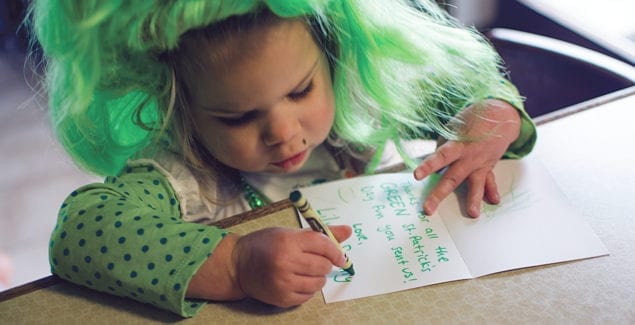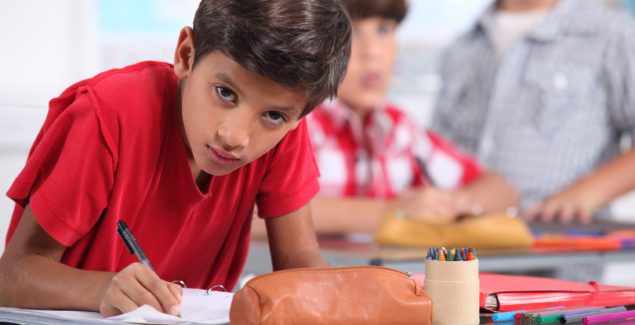The Unexpected Magic of Thank You Notes: 9 Strategies to Help Your Child Get Started

Posted in: Grade School, Parenting Concerns, Teenagers, You & Your Family
Topics: Child + Adolescent Development, Hot Topics
Mariela was so excited to graduate from middle school this spring. Even though the celebrations looked different this year due to the pandemic, she was moved by all the family members and friends who came together to celebrate this special milestone with her. The festivities included a car parade, a virtual party with relatives as far away as Mexico, and many thoughtful gifts. Mariela’s middle school graduation was made even more meaningful, given that she had been diagnosed with ADHD and executive function challenges at the start of 6th grade. After years of hard work, Mariela was having academic success and feeling excited about starting high school in the fall. Mariela also felt grateful for all the teachers, family, and friends who had helped her come so far. Yet, every time she thought about writing thank you notes, she began to panic. “I have no clue what to say!” she thought. “And, my handwriting is sooo messy. Everyone is going to laugh at what I write.” These thoughts made it difficult for Mariela to get started on her thank you notes, and her parents’ frequent reminders to “just get it done” weren’t helping. What could Mariela do?
Most people agree that writing thank you notes is the “right” thing to do following a birthday, holiday, or special occasion. And most adults agree that the practice of writing thank you notes – and cultivating expressions of gratitude – is important for children and teens to develop early. Today, where the average U.S. resident sends about 100 text messages per day, most would agree that receiving a hand-written note of sincere thanks is extra special. But there are a surprising number of barriers to writing thank you notes, from feelings of self-doubt and awkwardness, to the myth that thank you notes are so old-fashioned that nobody sends them anymore. Even more, these concerns are often heightened for children with learning and attention issues.
Perhaps because people tend to accept that writing thank you notes is a nice thing to do, there aren’t many research studies that examine the practice. However, the existing research – while small – is overwhelmingly positive.
The Positive Research on Expressions of Gratitude
The most recent study to date on the act of writing thank you notes, and the kinds of feelings they bring in both the writer and the receiver, is from 2018. The collection of mini-studies in the study shows the positivity of thank you notes – or, as they were called in the study, “gratitude letters”. Overall, writing a gratitude letter was a positive experience. More specifically, most participants reported being in a much more positive mood than usual right after writing one. Furthermore, the people who received letters felt more positive, more surprised, and less awkward than the writer thought they would. It turns out that both sending and receiving thank you notes makes people feel great!
While this study only included adults, and the type of thank you note wasn’t always specified (e.g., hand-written versus email), it likely has takeaways for children and teens, too. More research, especially with children and teens, is needed to understand just how far the benefits of writing thank you notes go. That said, growing research on gratitude further supports the benefits of thank you notes, since writing them is an expression of gratitude, and this research does include young people.
Research shows that children and teens feel gratitude for presents they receive, and that their understanding of gift-givers’ intentions plays a role in these feelings. Research among adults shows that developing a gratitude practice helps to increase well-being and one’s ability to cope when things go wrong. This is true even when the gratitude practice is solo – for example, writing down three things one feels grateful for, or writing but not actually sending someone a gratitude letter. The wonderful thing about sharing a thank you note with someone else, though, is that it not only cultivates one’s own gratitude – it also benefits how the other person feels. Especially during the pandemic, when many traditional acts of kindness are simply not options, writing a thank you note remains a safe – and surprisingly gratifying – way to connect with someone else.
Making Thank You Notes Easier
While research strongly hints at the benefits of thank you notes, for both the writer and the recipient, this doesn’t mean they are always easy to compose. Writing involves multi-tasking, and it can be taxing on one’s executive functions (i.e., the ability to break larger goals into smaller tasks, and to follow through with those smaller tasks without getting distracted or off-track). This is especially true for children and teens who struggle with these skills.
Below are nine simple strategies for making thank you notes easier, less stressful, and more fun to write:
- Increase their excitement. Involve children and teens in choosing their own stationery, pens, stamps, and accessories, like stickers. This helps to increase buy-in and excitement to use the materials.
- Sooner is better. When it comes to writing thank you notes following an event or occasion, the sooner, the better. This way, the event will be fresh in their memory, and they might be able to include specific details in the note. Also, the longer you wait, the more challenging it may be to get started.
- Keep it simple. The best thank you notes are simple and straightforward. Many examples of note structure and sample wording for different occasions are available online.
- Use a template. Making a template and writing it out on a piece of paper that is the same size as the notecards they’ll be using is good practice. It also helps to build “muscle memory” and reduce working memory demands while writing the notes.
- Use lined cards. If writing on blank notecards is challenging, consider using pre-lined cards, or using a pencil and ruler to draw light lines.
- Work with your child’s skills. Some children and teens do not have the skills yet to fully hand-write thank you notes – this is okay! Other options include fill-in-the-blank style notecards, or sending thanks electronically (by typing or using speech-to-text dictation technology).
- Set reasonable expectations. While some kids might be able to do a note-writing “marathon” and complete theirs all in one sitting, this is not possible for everyone. Some kids do much better with writing one or two notes per day, until they are all finished.
- Offer external motivation. Until writing thank you notes becomes a more rewarding task in and of itself, children and teens may need external rewards to stay motivated. After all, most adults enjoy getting recognition for a job well done, too! For some children, this might look like a special treat or outing once their notes are all finished. However, other children need smaller and more frequent rewards to stay on track while writing their notes.
- Model the practice. Adults can model writing thank you notes (and positive feelings about writing them) for children and teens.
While most people agree that writing thank you notes is a thoughtful thing to do, myths, barriers, and negative self-talk often get in the way of doing what matters. And if adults feel weighed down by these, it is likely that children and teens feel the same. Fortunately, research shows that writing thank you notes is much less awkward than you might expect, that people will feel happier and more surprised than you might think to receive your note, and that you are likely to feel happier after writing it. Especially during times like these, writing a simple, sincere note of thanks is a wonderful thing you can do to boost someone else’s well-being – and your own!


 Share
Share Tweet
Tweet





